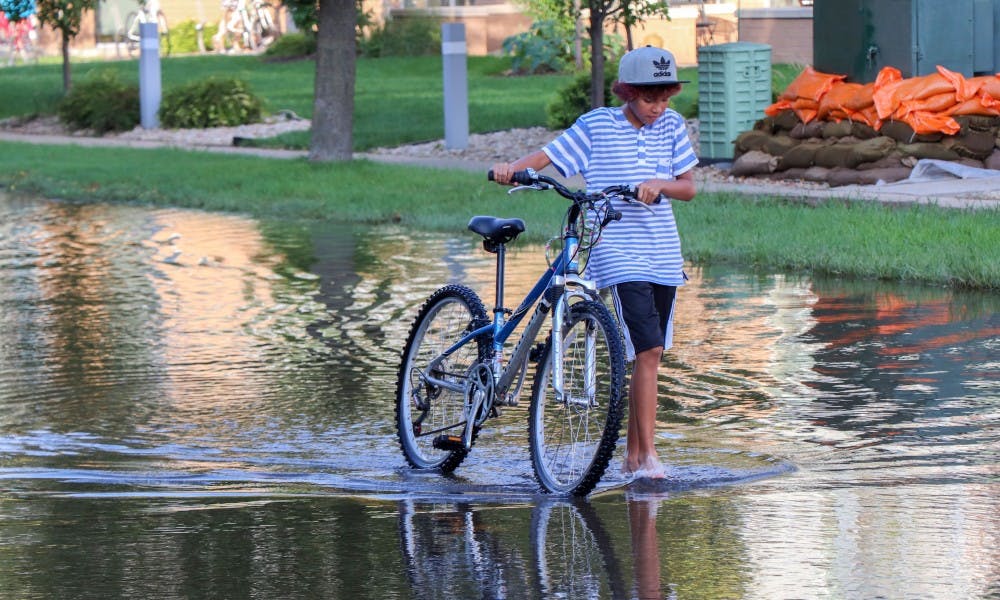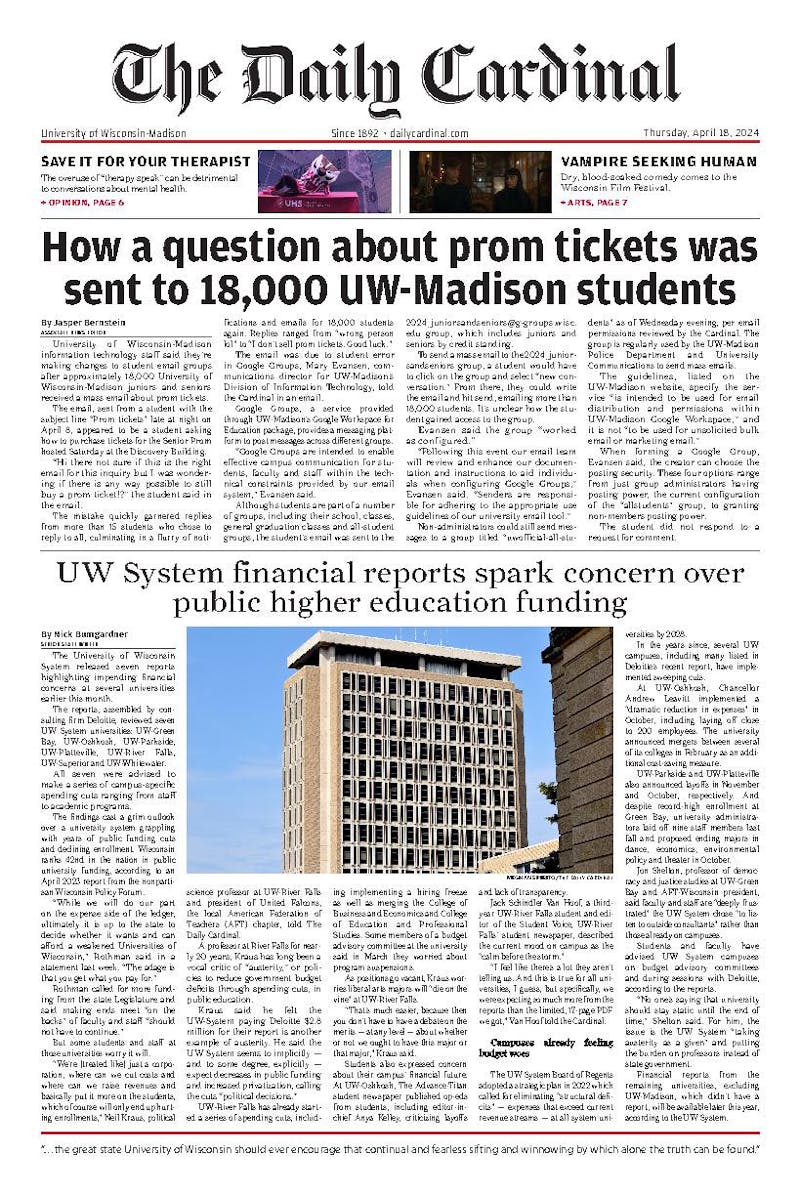Last month, CBS News set out to find a “climate change haven.”
Where, they asked, should the average American seeking shelter from a burning world settle down? Somewhere far from the blazes of the West Coast, the heat waves of the South, the rising seas of the Atlantic coast, the hurricanes of the gulf. Somewhere “almost perfect” to avoid the violent extremes. One place, they concluded, fits the bill: Madison, Wis.
But were they right?
It’s true that, compared to cities in the American south and west, Madison will fare well in the looming climate crisis. The most catastrophic effects of a warming world do not threaten to wipe the city off the map, but climate experts say that Madison is already changing. More frequent and powerful thunderstorms as well as warmer, shorter winters are giving the isthmus a taste of dramatic changes it may see in the coming decades. Such changes have the potential to substantially shift the region’s economy and way of life.
According to a report last year by the Wisconsin Initiative on Climate Change Impacts (WICCI), Wisconsin is already 2.1 degrees Fahrenheit hotter today than in the 1950s. One effect of that warming is the air can hold more moisture — and unleash heavier rainfall.
“It’s almost like a sponge effect when a storm comes through,” explained Michael Notaro, the associate director of the Nelson Institute’s Center for Climatic Research. “Those heavy precipitation events are becoming more frequent and more intense during the last several decades.”
Notaro referred to storms like the ones that clobbered Madison in August of 2018, when days of downpour flooded much of the isthmus and wrought what Dane County Executive Joe Parisi called “historic” damages, totaling over $154 million across the county. More than half of those costs fell on the heads of private residents, only 2 percent of whom were insured for flood damage. One man was killed, swept away in the deluge that made rivers and lagoons of Madison streets.
In that month alone, 10.4 inches of rain battered the city. The floods, and the similarly stormy May that preceded them, made 2018 the second-wettest year in Madison’s recorded history. Official records report 3.78 inches of rainfall in Madison on August 20, the epicenter of the storms. According to WICCI projections, such torrential days — over three inches in 24 hours — could be 33% more common by mid-century.
“The heavy precipitation events becoming more frequent is not something that’s going to go away,” Notaro said. “It’s a serious matter.”
There is even evidence that, for all the damage incurred, Madison actually dodged a bullet with the 2018 storms. A report written by Daniel Wright of the Civil and Environmental Engineering department at UW-Madison found that the most intense rainfall in the 2018 storms fell to the southwest of the Yahara Watershed, the giant geological drain that feeds into Madison’s lakes.
Wright found that had the storm shifted by just 15 miles, the water dropped into the watershed — and thus into the lakes and streets of Madison — could have nearly doubled. This worst-case-scenario storm, Wright wrote, could have been “absolutely catastrophic” for the city’s lakefronts and low-lying neighborhoods.
But the effects of a wetter Madison are broader than the damage left by the rare mega-storm.
According to WICCI maps, since 1950 annual precipitation in the Dane County area has already increased by about 20 percent. According to Chris Kucharik, a UW-Madison professor and member of the WICCI working group on agriculture, farms like the ones that cover two-thirds of Dane County’s land are already seeing increased runoff from the rains. That carries consequences for crop maintenance and water quality.
“[Farmers] are at the mercy of mother nature. If a heavy rainfall comes a day or two or even a week after they’ve applied that fertilizer, a lot of that can leech really fast right past the root zone and become unavailable,” Kucharik said. “It then ends up in the groundwater or gets run off into a lake or a stream.”
Heavier rainfall makes it harder for farmers to keep nutrients in the soil for their crops. Kucharik said that this leads some to apply even more fertilizers and produce even more runoff, which damages water quality and can contribute to harmful algae blooms.
“This is a negative feedback [loop] for water quality,” Kucharik said.
A warming climate also leads to transformational impacts on Wisconsin winters. Natalie Chin, a member of WICCI’s working group on tourism and outdoor recreation, said the season for pastimes that are central to the state’s — and to Madison’s — economy and culture will likely shrink.
“We worry about less reliable snow and ice cover, and that can create dangerous conditions,” Chin said. “The ice might not be as thick for ice fishing or ice skating or other kinds of winter recreation activities.”
In 2017, the Birkebeiner, North America’s largest cross-country ski race, which takes place annually in Northern Wisconsin, was cancelled due to “unseasonable weather” and a lack of snow cover. Earlier this month, firefighters in Duluth, Michigan, rescued 26 fishermen from an ice floe on Lake Superior that cracked and floated out into the lake. According to Eyewitness News, the lake had an ice cover of only about 10 percent, well below average for the time of year.
While it’s difficult to attribute such individual events to the impacts of climate change, clearer evidence of change can be found in the longer term. In Madison, records dating back more than 150 years show the average duration of ice cover on Lake Mendota is 25 percent — one full month — shorter today than it used to be.
Tourism, closely linked in Wisconsin to many outdoor activities, accounts for $22.2 billion of the state’s economy, according to the Wisconsin Department of Tourism. While researching for her PhD, Chin says she spoke with many of the business owners already grappling with the reality of a changing climate.
“Some of the things that I heard were expanding winter offerings — offering snowshoes instead of just cross-country skis since you can snowshoe in less snow,” Chin said. “Other things people talked about were expanding their summer offerings, not just being a winter destination.”
One study on climate change impacts in the Midwest found that by the late 21st century, the total number of annual snow days throughout the region could drop by 30 to 60 percent, depending on carbon emission rates.
As some who have wrestled with Madison winters might attest, the effects of a warmer regional climate may not all be bad.
In fact, Kucharik says, shorter winters and a longer growing season may well be a benefit to some of the farmers who call the city’s limits home. The optimal conditions for growing corn that bless much of Illinois and Iowa are likely to shift northward over time as the entire Midwest warms.
Madison has also been spared — at least so far — the increase in extreme heat events that many climate models suggest. Kucharik says that the number of days per year that top 90 degrees Fahrenheit has been stable in recent years, despite predictions that they could as much as quadruple by mid-century.
“That’s obviously been good,” Kucharik said. “But if you put trust in the climate models, at some point we’re likely to start going up significantly.”
Even as the effects of climate change take hold at the local level, experts agree that Madison offers refuge from the disastrous effects that climate change will wreak elsewhere.
“It’s a very different story than when you’re talking about a wildfire or a hurricane, where a community can be gone after that,” Notaro said of the 2018 floods. “I think Wisconsin is pretty resilient and able to persevere through these extremes.”
As communities across the country begin to feel the brunt of rising seas, deep freezes, biblical storms and terrifying blazes, that may be the best Madison can ask for.
“I don’t think there’s any part of this country that’s not going to be hit and hasn’t already been hit hard by climate change,” Notaro said. “So, in a relative sense, it is a haven.”






